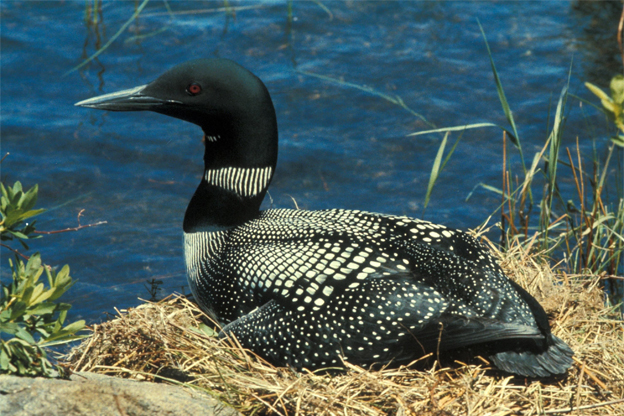

Kiss the loons goodbye
Gavia immer, that is
When you’re in the BWCAW or environs, the cry of the loons at dawn and dusk haunts your soul. It is one of the signature experiences of going there, and no recording does it justice. A new study reveals how sensitive loons are to their environment, particularly mercury and acidification of surface water they inhabit.
Although it doesn’t look especially fearsome — unless you’re a fish skewered on its bill, I suppose — the loon is at the top of its food chain (well, almost). They are an indicator species; they accumulate toxins from the little fish that are eaten by the bigger fish that are eaten by the loons. From the linked report:
[ ] Acids [from precipitation or from other sources, like mining], and the toxic metals they mobilize, interfere with fish gill function. This, in turn, reduces fish growth, reproduction, and survivorship, and results in lower fish abundance in more acidic lakes. As a result, Common Loons produce fewer young on lakes with low pH and produce more young on lakes with high pH (see box). Acid precipitation, like mercury, directly impairs Common Loon reproductive success.
Loons are long-lived birds that winter in the ocean and migrate to places like the BWCAW and northern Minnesota (and Canada) to nest and raise their young. They often return to the same lake year after year.
Again, according to the report, loons are not exactly rabbits in the reproduction department. Point four eight (.48) chicks per pair that make it to six weeks old in a given year is good. That means, in round numbers, that it requires a pair of loon four years to reproduce themselves.
Lakes in and around the BWCAW are infertile and acidic, in other words, they already have a low pH. They have little or no capacity to “buffer” additional acid inputs from acid rain, or from acid-polluted runoff from, inter alia, a tailings basin leak or failure, or a waste rock or “lean ore” pile (Brimstone Mountain).
It wouldn’t take much, kids, for Mr. and Mrs. Loon to fall off their .48 chicks per year target on your favorite little BWCAW lake (which are more vulnerable than big lakes) and before too many years, there aren’t any loons.
The first of the four questions that Mining Truth wants our political leaders to answer about sulfide mining is: Will Minnesota’s water stay safe and clean?
They’re not only asking for you; they’re asking for Mr. and Mrs. Loon, too.
Thanks for your feedback. If we like what you have to say, it may appear in a future post of reader reactions.

